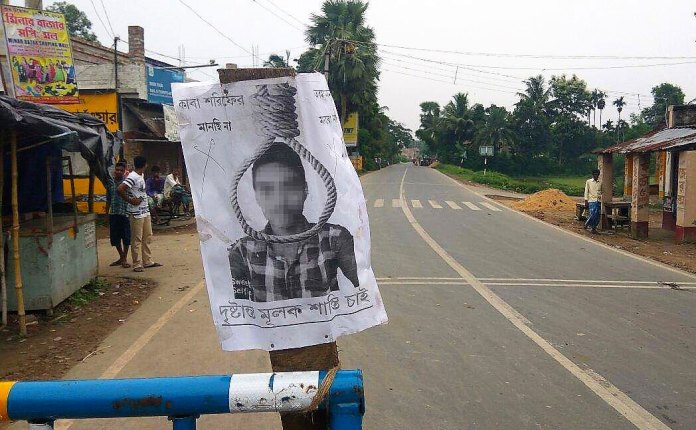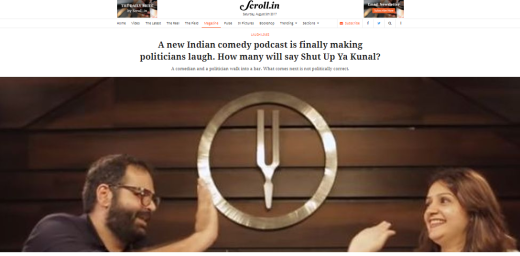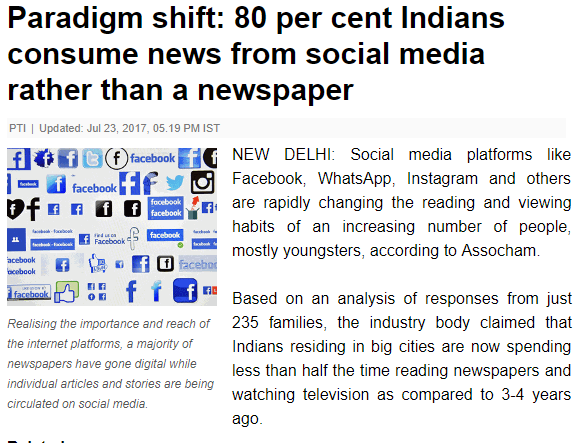Communal tensions in West Bengal owing to activities of emboldened Islamists are now well known. The latest example of this menace was Basirhat riots last month, where a Facebook post by a minor was found too provocative by Islamists, who indulged in widespread arson and violence leading to death of at least one person.
The incident made it to the national media too, though there was attempt to paint the violence as some ‘natural reaction’ to the ‘grave provocation’. It also resulted in lot of political heat with the BJP taking on Trinamool Congress, which is in power in West Bengal.
While everyone was busy in either scoring ideological or political points, hardly any thought was spared for the minor who was not only facing threat to his life, but was even wronged by the state, which arrested him and treated him as an adult criminal.
However, the 17 years old boy was not left entirely alone to fight out this legal battle. A local outfit named Hindu Samhati decided to help him, and recently it was revealed that the organisation could obtain a juvenile status for the boy, who would now be sent to a juvenile correction home and not be kept along with grown up criminals in a jail.

OpIndia.com talked to Prasun Maitra, a Kolkata based Hindu Samhati activist, advisor and member of State committee. Here are the highlights of the interview:
Q1. Can you tell us a little about the minor? Obviously, we can’t disclose his identity, but something related to his family and the problems they had to face after the alleged Facebook post was created by him?
The boy belongs to a poor family. He had lost his mother early in his age. He used to live in the house of his elder uncle, who resides nearby. After his, alleged, post on Facebook, his house and that of his uncle was under attack of violent jihadi mob, who set other houses and properties on fire too. Absolute rampage went on for hours that day, which only spread to nearby areas in the following days.
Q2. Was Hindu Samhati approached by the family or friends of the minor seeking help, or your organisation decided to take suo moto action?
Family of the boy approached us through our Vice President, Adv. Brojendranath Roy, and they were accompanied by some local youths.
Q3. When did you or the organisation discover that the boy was underage and the police had erred by treating him as an adult?
Once we came to know that the boy appeared for the 10th exam a while ago, we were sure that he was a minor. Further, documents like birth certificate, Admit Card, etc. which were provided by his family, substantiated our assumption.

Q4. Do you think police erred or it was deliberate? If deliberate, what did they try to achieve by this step?
Yes, it was deliberate act by police to frame him and that’s why police didn’t mention his age in the FIR (copy). In fact, the whole thing was so shoddily done that they haven’t even bothered to mention age of even the complainant in the FIR. They were in a hurry to arrest him basically and not bothered about age.

Essentially the West Bengal Police, who were helpless to counter violent jihadi mob throughout the area, found the Hindu juvenile as soft target. And this pattern of police is very common. They fail to act against jihadis due to political and departmental pressure, so they resort to targeting Hindus.
It happened in Tehatta, Howrah where school children were deprived of their right to observe Saraswati Puja in school, it happened in Nandigram, Purba Medinipur where Muslim students ransacked school in their demand for special leave for Friday namaz and change of direction of toilets that faced west.
The list is very long but the bottom line is same. Hindus should compromise to jihadi demands, else face legal consequences.
Q5. How long and challenging was the legal battle? What kind of problems Hindu Samhati or the minor had to face during this?
We made our first attempt in the court on 20th July, 2017 and demanded juvenile status for the boy who was charged with 295-A of IPC along with 66 E/67 of IT Act. The Hon’ble judge of Basirhat ACJM court asked for some time to verify the documents and also asked the IO (Investigating Officer) to submit his report by 3rd August.
On 3rd, police failed to submit the report and the court strongly admonished them. They were asked to submit the report within 2 days i.e. by 5th August. On 5th August, when the matter was taken for hearing, police acknowledged that the documents submitted by legal team of Hindu Samhati were real.
But to deny the boy of his constitutional right, police brought Special Public Prosecutor from Kolkata. They were not willing to let the boy go, perhaps to keep the Islamists happy who demanded death penalty for him.
But all their misadventure went in vain as the Hon’ble judge relied on the documents presented by us, and passed an order to move the boy to a juvenile home.
We had also made an appeal to the National Child Right Protection Commission to ensure right of the juvenile, and the commission had issued a letter to the DM regarding the same.

Q6. What happens now? The boy will be shifted to a juvenile correction home and await verdict? How long he might have to be there given the charges slapped on him?
It depends. The situation in his village is not welcoming for him. So, for his own safety and security, he should stay in the juvenile home for some time. Once the situation becomes normal, we’ll consider getting him released and take back to his own house. But if that still remain risky, we’ll explore other alternative arrangements.
Q7. How is the boy’s current mental status? Is he still under stress? How does he feel about entire episode?
He is shocked and why not, he is merely 17 years of age. It’ll take some time to recover from it. Earlier, Sujan Mukherjee of Ilambazar, Birbhum went through such traumatic situation when thousands of Muslims attacked his house for a Facebook post. Trauma inflicted by Islamists is appearing to be the new normal in Bengal these days.
Q8. Many media organisations carried the photo and name of the boy while reporting about Basirhat riots. This was clear violation of the law as one is supposed to hide the identity of a juvenile. Now that the court has accepted that the boy is a minor, do you plan to take some media organisation to task?
Although the media is biased in India, I will still give them benefit of doubt. Perhaps they were not aware of his juvenile status as even the state police didn’t treat him like that. I would like to believe there were no ill intention involved in that. Now, once the court has accepted his juvenile status, if somebody does it now, we’ll definitely take it seriously if that is brought to our notice.
Q9. Did Hindu Samhati receive any support – legal or financial or even moral – from any other group, especially BJP or the RSS?
No, an emphatic NO! On the contrary, Union Minister and BJP leader Mr. Babul Supriyo clearly said during a TV debate on Republic TV that the boy should be punished and example be set. I wonder, if Mr. Supriyo made any such statement when Md. Afroz, accused of rape and murder of Jyoti (Nirbhaya) got away with juvenile status. I fail to understand how can a responsible minister like Mr. Babul Supriyo can demand punishment for a juvenile even before trial. Does he also believe in Sharia law where the juvenile has to be punished for blasphemy?

Q10. Do you think BJP tries to present a ‘moderate’ or ‘secular’ image in the West Bengal? What is the reason in your view?

In West Bengal, both the RSS and BJP consider Hindus as their natural voters. They believe, or take for granted that Hindus will automatically slide towards them due to their resentment against Mamata and her extreme Muslim appeasement policy. That is why they do not feel any urge to support Hindus. Instead they go for the Muslim vote bank as it will be additional bonanza for them. This is the reason RSS is sending postcards to Muslims to change their mindset.
On the other hand, BJP indulges in taking out rallies to demand justice for alleged victims who belong to the Muslim community. Look at this rally organised to demand justice for Rizwanur Rahman, who was accused of love jihad and allegedly killed by his father-in-law, and for another guy named Amirul Islam who had immolated himself after another Muslim had accused him of criminal acts. Did the BJP take out any rally to demand justice for the Basirhat boy?

Q11. Some commentators have claimed that West Bengal is inherently ‘secular’ and believes in ‘composite culture’ and thus political success may not come to BJP if they take on hard-line approach? What is your reaction to such arguments?
I really don’t know what is hard-line or what is soft. What I realize that Hindus never attack Muslims out of their own. It is not in their DNA. What Hindus do, is only for self-defence or at worst in retaliation, because the police and government don’t act. If those commentators feel that surrendering to unjust jihadi demand is soft-line and raising voice for own existence is a hard one, I would always stand for that hard line. It is a question about safety and security of our future generations as well. We just can’t leave them in a Sharia ruled state.
Q12. How does Hindu Samhati see the West Bengal society? What do you think are the biggest challenges?
Hindus in Bengal have never been short of courageous fighters. What they actually lack is courageous leadership. We have enough fighting forces in our society, mostly from, so-called backward classes, who are ready to fight against jihadi atrocities. What we need is to give them support – legal, financial, moral, medical.
Thousands of Hindu Samhati activists are fighting against Islamic aggression in different parts of the state. Last year, we have successfully started Durga Puja in Kanglapahari village in Birbhum, which was stopped for decades due to jihadi pressure. Hindus need to fight to preserve their identity and culture that is increasingly under attack from jihadis and a complicit government.
Q13. In the usual left-liberal narrative, Hindu Samhati will be identified as “fringe organisation”. But how big is the organisation and its support base? Any plans to expand outside West Bengal?
We already have started our activities in Assam and Jharkhand. Left calls us “fringe organisation” as our work is exposing their hypocrisy. We believe that Mamata Banerjee is inheriting this hypocrisy of the Left, but we are determined to turn the table in the years to come.
This year, more than 100,000 people joined our Foundation Day rally at Kolkata on 14th February this year and that was alarming for every political party who takes Hindus for granted.
Q14. Any plans to join active politics and fight elections?
Even though we are getting huge number of appeal from all quarters to start a political party, but we have not decided it yet. But we are free to accept any idea for empowerment of Hindus.
We would like to reiterate that Hindu Samhati is an apolitical organization and works for uniting Hindus irrespective of their political inclination. We don’t believe any single party can be termed as Hindu party right now. So, our target is to capture Hindus scattered in different parties and motivate them to work for safety and security of Hindus and resist Islamic aggression.



















